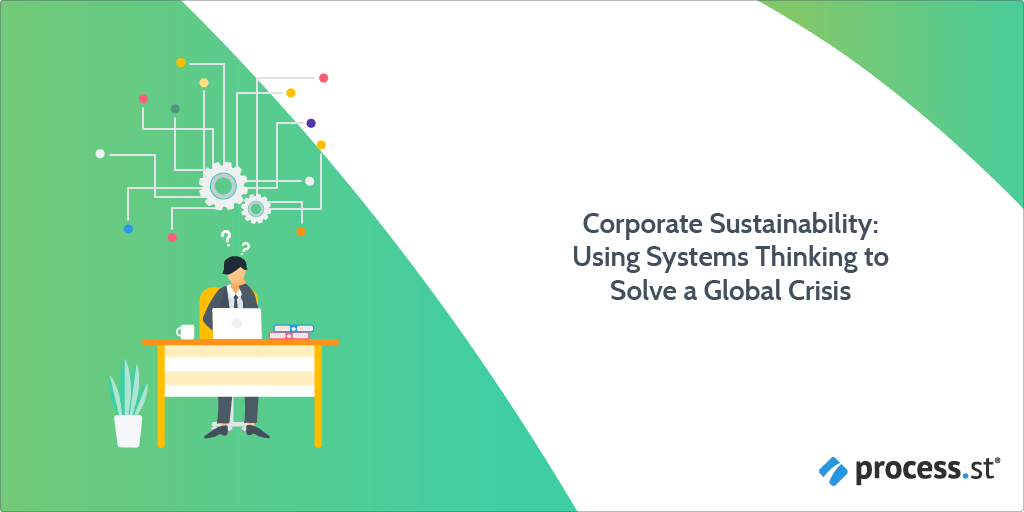
90% of the largest companies are filing sustainability reports, with 80% of mainstream investors considering environmental, social and governance information when making decisions.
Understanding and practicing correct corporate sustainability strategies has never been more important.
In this article, we at Process Street explore what corporate sustainability is, taking a system thinking approach to acknowledge the complexity of the problems.
We then turn our attention to top business owners and employees across the globe, asking the question: How are you managing sustainability in your business day-to-day?
Here you are provided with our top 5 never-before-seen best practices to achieve corporate sustainability.
But before that, we begin this article with Process Street’s 6 leading corporate sustainability templates, which you can access for free.
Click on the relevant subheader below to jump to that section. Alternatively, scroll down to read what we at Process Street have to say regarding corporate sustainability.
- Corporate sustainability templates
- Corporate sustainability definition
- How to be more sustainable: System thinking
- Capturing opportunity for corporate sustainability
- Use Process Street as a tool to help you achieve corporate sustainability
Corporate sustainability templates
We at Process Street have been working hard to create templates that will assist in the creation of a sustainable business. Below I have embedded a snap-shot of our top 6 sustainability-focused templates, free and ready for you to use right away.
A more comprehensive template list is provided at the end of this article. Freely use any template from this list, to help you reach your corporate sustainability goals.
BSR Greenwash Prevention Checklist
Greenwashing is an unethical marketing tactic, that deceives the consumer, covering up questionable practices. Run this BSR Greenwash Prevention Checklist to follow the Business of Social Responsibility guidelines and assess whether you are communicating your environmental efforts both honestly and effectively.
Click here to access the BSR Greenwash Prevention Checklist!
To learn more about Greenwashing read: Greenwashing: What It Is and How to Stop It (Free Template)
Environmental Management Self Audit Checklist
Run this ISO 14001 Environmental Management Self Audit Checklist to perform an internal audit on an Environmental Management System (EMS) against requirements set out in ISO 14001:2015.
Click here to access the ISO 14001 Environmental Management Self Audit Checklist!
Achieving Work-Life Balance Checklist
Run this Achieving Work-life Balance Checklist when you need to do just that. Working outside working hours is not conducive to an employee’s good health, and therefore does not create a sustainable working environment.
Click here to access this Achieving Work-Life Balance Checklist!
Gap Analysis Template
Many sustainability initiatives look to improve upon a business’s operations so that they meet social and environmental needs. The gap between current operations and areas for improvement can be closed via gap analysis. Run this Gap Analysis Template to find the skills you have and the skills you need to reach your organization’s sustainability goals.
Click here to access this Gap Analysis Template!
Environmental Management System (EMS) Implementation Checklist Template
Use this Environmental Management System (EMS) Implementation Checklist Template to help you create a plan for the development and implementation of your environmental management strategy.
Click here to access the Environmental Management System (EMS) Implementation Checklist Template!
ISO 26000 Social Responsibility Performance Assessment Checklist
Sustainability means meeting economic, environmental and social needs. Run this ISO 26000 Social Responsibility Performance Assessment Checklist, to assess your organization’s performance according to the social responsibility guidelines set out by ISO 26000:2010.
Click here to access this ISO 26000 Social Responsibility Performance Assessment Checklist!
Corporate sustainability definition
Corporate sustainability looks at the environmental, social and economic dimensions of doing business, to provide stakeholder value in the long-term.
Corporate sustainability is a discipline that operates outside traditional attempts at business, that are short-term and profit-focused. It is an evolving paradigm that recognizes the importance of corporate growth and profitability, whilst also pursuing societal goals in relation to environmental protection, social justice, and equality.
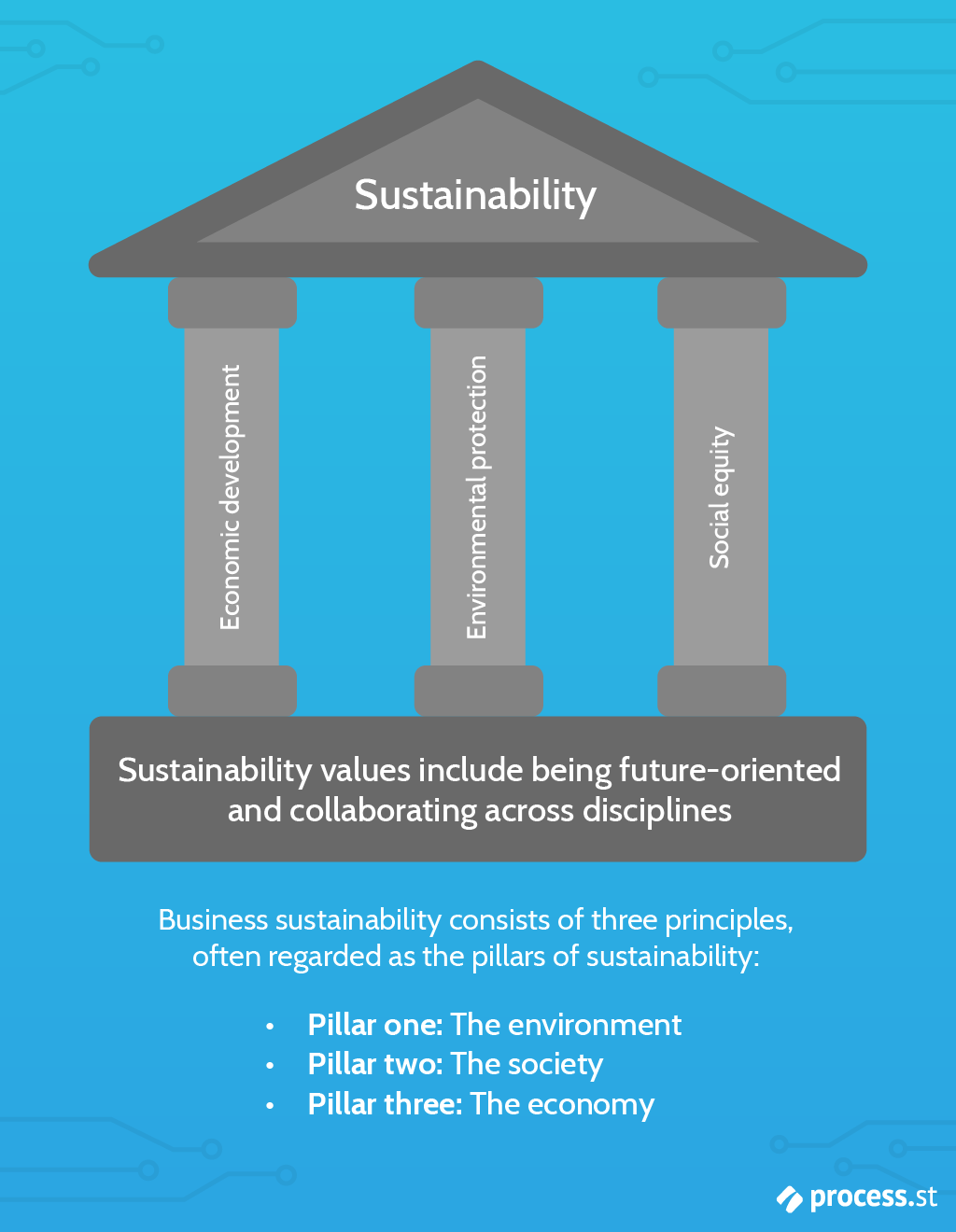
A sustainable business is supported by three pillars:
- Pillar one: The environment
- Pillar two: The society
- Pillar three: The economy
A traditional business model only addresses the economic pillar. With one pillar of support, you can see how such a design is unstable, and therefore only blindly advantageous in the short-term.
A sustainable business looks at these three pillars and focuses on their interaction. A widely supported model detailing this interaction is the nested dependency model, given below.
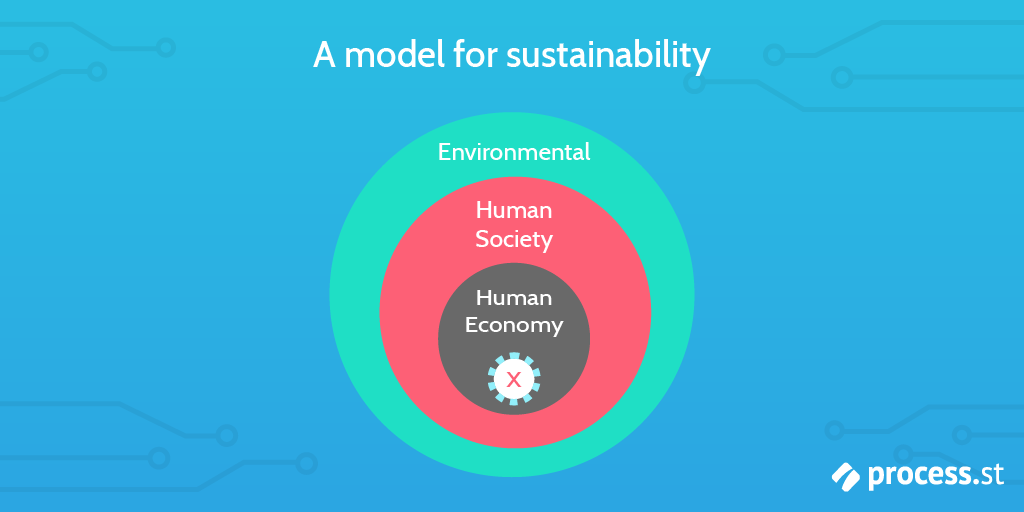
This model represents the co-dependency between our economy, society and the environment.
Above all, the environment takes precedence, with human society and the economy as subsidiaries. That is, neither society or our economy can prosper with the poor health of our natural ecosystems.
Think about it, the economic value of our natural world is £125 trillion. This value comes in the form of fresh water, pollination, materials, medicines, shelter, protection, and food. These are natural services that every single business depends upon. If these services are squandered, where would a business go?
Next comes society. Poverty-stricken, fragile communities do not induce economic health. By looking after society, a company’s bottom line benefits.
To summarize the nested-dependencies model, I take a quote from my previous article, How You Can Create a Sustainable Business For Long-Term Success:
“From the small-scale economy of a single business, up to the larger-scale global economy, all financial facets are at the mercy of social and environmental factors, and it is the environment that ultimately deals the trump card“
Why sustainability is important: The benefits of corporate sustainability
To be sustainable means maintenance at a certain rate or level for as long as it is wanted. If you apply that definition to business, you can see why a sustainable business is desired. It means long-term business success, mitigating many external and internal risks.
However, as a relatively new discipline, business sustainability often requires an initial investment of both time and money. Therefore, corporate sustainability can be seen as a hindrance to growth and prosperity in the short-term rather than a driver. This is, however, a false illusion.
In addition to the long-term benefits that are a given, setting up your business to be sustainable also brings short-term advantages, offsetting initial investment costs:
- Heightened brand value.
- Greater customer loyalty.
- Greater product or service worth, with customers willing to pay more for greener alternatives.
- Assistance in bidding for contracts, from governmental or corporate bodies who work with sustainability.
- Be able to scrutinize your overall business functions, specifically where you are wasting time and effort. For instance, incorporating environmental accounting procedures can reduce energy costs.
How to be more sustainable: System thinking
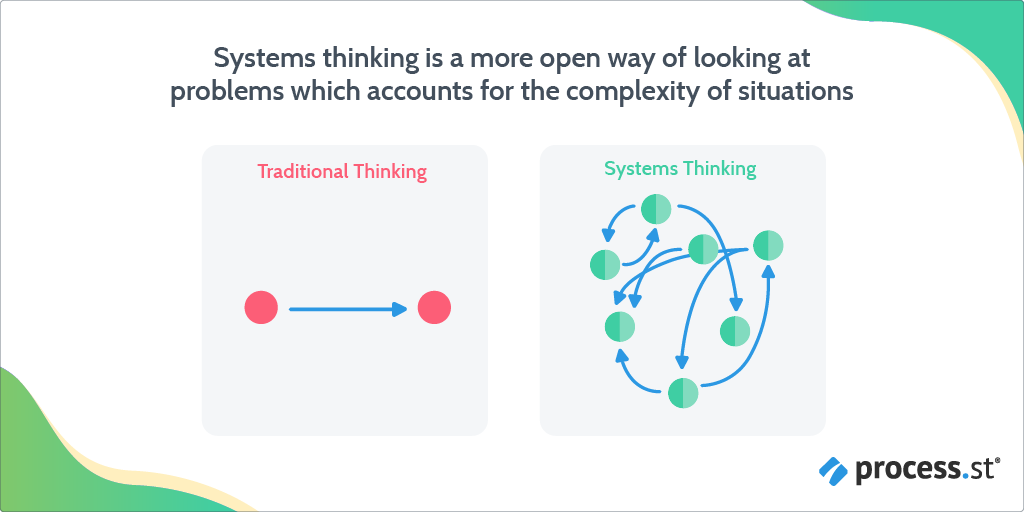
System thinking takes a holistic approach to a problem, looking at how a system’s constituent parts interrelate over time. It is about understanding the full complexity, knowing that a single action can have a domino of reactions over time.
Applying this approach is widely supported by Leyla Acaroglu, a sustainability provocateur.
Let’s take a systems approach to the idea of corporate sustainability.
The problem: To be more sustainable.
The solution: To take a systems approach and understand the complexity of interactions between:
- The economy and its constituent parts
- Society and its constituent parts
- The environment and its constituent parts
Solving problems via a systems approach requires categorizing a problem in terms of its attributes, that is, the relationship between the participants involved and the number of elements. Flood and Jackson (1991) were the first to pioneer a methodology to this, coming up with 3 ideal types of problem contexts:
- Type one ⇄: Simple-unitary, includes a small number of elements, with few interactions between elements, and well-defined laws of governance.
- Type two ↹: Complex-unitary, many elements, and interactions, sub-systems, and attributes that have not been pre-determined.
Further classification defines the relationships between participants of the problem context in terms of unitary, pluralists and coercive relationships.
- Unitary: Participants have common interests and act following agreed objectives.
- Pluralist: Participants have basic compatibility in interests, but values and beliefs diverge to some extent.
- Coercive: Participants have few interests in common and share conflicting values and beliefs.
Many sustainability problems can be described as coercive complex-unity, illustrating the intricacy of the issues.
Taking a system-thinking approach to corporate sustainability: Case study #1 – Tackling air pollution in Mexico city
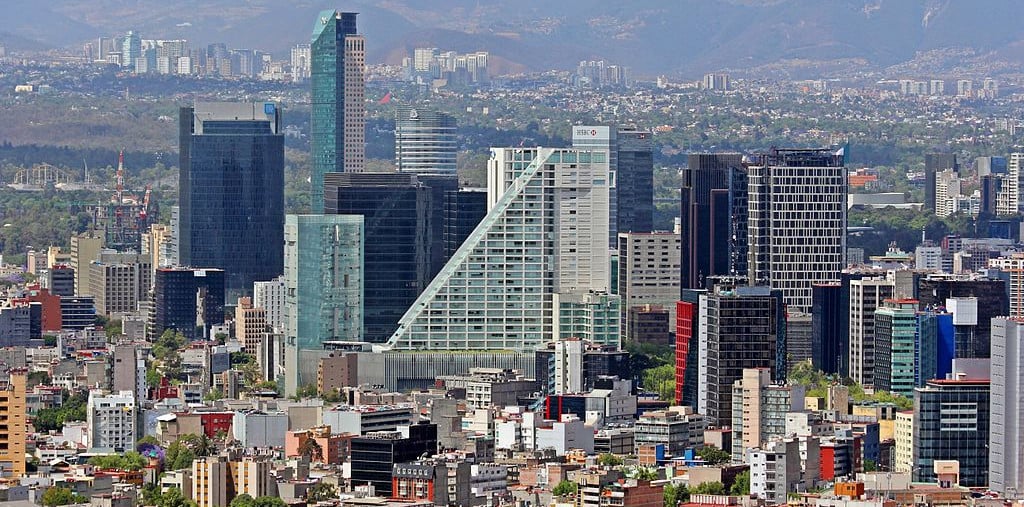
Mexico city wanted to reduce air-pollution from over-congestion. The Hoy No Circula program was introduced, banning drivers to use their vehicles one weekday per week based on the last digit of the vehicle’s license plate.
This movement was to encourage civilian car share, public transport use, walking, and biking.
The measures did not work…
…at all.
Instead, civilians went out and bought new cars, meaning most households had more than one they could alternate between.
Suddenly a situation arose where there was an increase in car ownership, car driving, and air pollution – with second cars often being cheap and inefficient.
Good intentions can often result in far bigger problems if the complexity of a system is not fully understood. This is of concern when considering global problems, such as climate change, deforestation, or poverty. When we don’t understand the consequences of our actions, there are dramatic flow-on effects. This example illustrates this.
Taking a system-thinking approach to corporate sustainability: Case study #2 – Biofuels

In 2003, to address the EU’s dependency on oil, investment and legislation were introduced to encourage biofuel use.
Biofuels are fuels that can be used in cars like any other synthetic fuel, but they are derived from living matter such as food crops, wheat, and corn.
A few years in, the introduction of legislation looked to be successful, so targets were increased to 10% (10% of fuels to be derived from biofuels).
It was then that problems started to arise.
Researchers began to question why there was suddenly less food available in the world food market. We are talking about basic food sources, such as rice and wheat.
What was the cause of this change to the world food supply?
The answer: Indirect land-use change.
Essentially, farmers that used to grow a large percentage of the world’s base food suddenly dropped from the market. It was becoming far more economically valuable to sell corn and maize as biofuels to Europe, as it was to sell food to Africa.
So there was a world food shortage.
Not only were people transforming their already farmed land, but they also cleared large tracks of the rainforest. The exact amount lost is unknown, but the number of acres is high into the thousands.
When considering the net environmental losses, you see that actioning biofuels was an unsustainable solution.
Systems as the underlying solution to corporate sustainability
Our planet is made up of many incredible and beautiful systems. You can think of these systems as the underlying code to everything that exists on Earth.
Systems not only include the big systems, such as climate regulation and industrial processes. System thinking also incorporates smaller-scale systems, such as family and friend relations. Both smaller-scale and larger-scale systems interrelate.
Without understanding this system complexity, as we have witnessed, there are unintended consequences to corporate sustainability measures.
For more information on the system thinking approach to sustainability, watch: Why We Need to Think Differently About Sustainability, a talk by Leyla Acaroglu.
Capturing opportunity for corporate sustainability
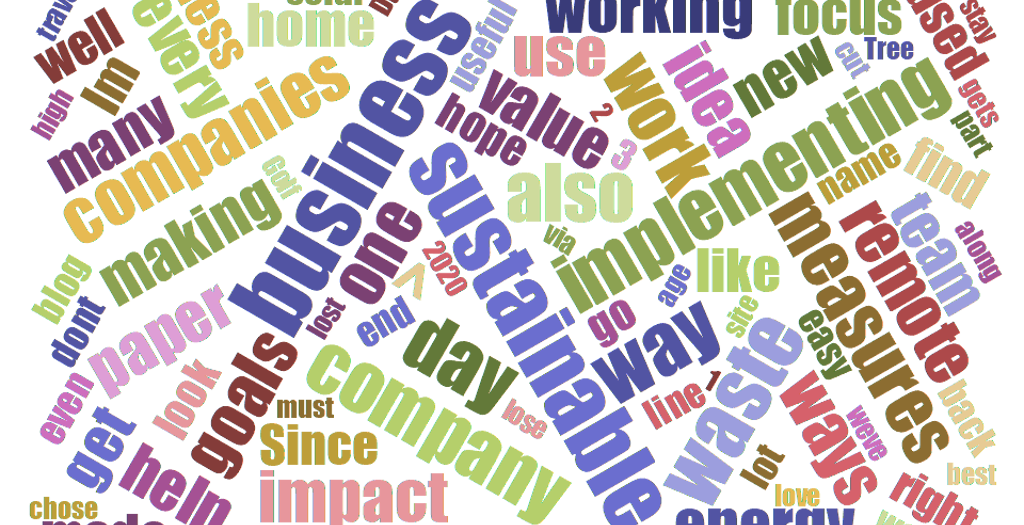
How are you managing sustainability in your business day-to-day? Source
Sustainability is about self-preservation, doing more with less. This includes sustaining ourselves – in terms of our needs – whilst also sustaining the nourishment of our families, friends, communities, and our environment.
Sustainability is:
As more and more people demand the same quality of life as we have in the western world, we need to understand more, to figure out how to do more with less, for the preservation of life quality as we know it.
Sustainability is a catalyst for innovation, to evolve how we currently do business. Despite this, only 2.7% of all new patents have anything to do with the environment.
If we want to solve a problem, we cannot approach it with the same thinking that brought us there. As with the two case studies presented above, sustainability solutions that are short-term, fail to solve complex and long-lasting problems.
We need to re-invent and capture the huge gap of opportunity, to create more sustainable businesses and therefore a more sustainable world.
We put forward this question to top business owners and employees across the globe, to determine how they are working to become more sustainable. We asked: How are you managing sustainability in your business day to day?
Below I give you the 5 top approaches.
Capturing opportunity for corporate sustainability: Approach #1 – Going paperless

Business is founded on paper. With that in mind, 85,000,000 tons of paper is used in the U.S. each year. What we want to know is: what role do paper products play in terms of sustainability?
Deforestation is rife across the planet, with an area the size of the UK being lost per year globally.
The most significant threat to our forests is the expansion of agriculture and biofuel plantations. However, deforestation for paper manufacture does grasp a culpable portion of responsibility. Once more, roughly 26% of solid waste dumped is paper and cardboard.
Emissions from different pulp and paper industries have a significant effect on the environment, spurring out nitrogen oxides, sulfur oxides, and carbon dioxide. Chlorates pollute rivers and lakes, a waste product from the manufacturing process.
1% of global transport and energy use comes from paper.
Reducing paper-use will not solve our global environmental crisis. It is though, a step in the right direction.
By reducing paper-use we are taking a system-thinking approach, looking at a problem with innovative thinking to do business differently. That is, solving the corporate sustainability problem by working to use-less.
Top business owners and employees around the globe agree. Russell Michelson from The Law Offices of Jezic & Moyse says:
“We have made a conscious effort to reduce paper waste in our office by making all communication within the company completely digital. All of our documents are distributed electronically, and only what is necessary to print gets made into a physical copy. Since we have implemented this decision, we have reduced paper waste in our office by over 95%. It is a small gesture to help out our sustainability efforts, but if more companies begin this practice, we can have a huge impact on the collective waste in the world“.
Marina McCoy from Her CEO has also worked to reduce paper use, to improve the sustainability of her business. She says:
“One thing I have been trying to do for the past few years is to use less paper and keep everything online to improve business sustainability. One challenge I’ve faced while doing this is that it is hard to measure the quantity of waste I was creating when I started, and hard to measure progress concretely. Documenting each time I print a lot of paper, or impact the environment in some way with business actions, is one way to keep track of progress and a great way to look back at how far you’ve come.”
Capturing opportunity for corporate sustainability: Approach #2 – Going remote

Ryan Anderson from Bead the Change explains how lockdown during COVID-19 has pushed him to become a more remote-based company. From this change, he has not looked back:
“Our company has started implementing remote work due to the recent stay at home orders and will continue to allow remote work when things return to normal. Allowing employees to work from home reduces the carbon footprint of the company, as well as the waste we produce and the energy we use in the office. We are always looking for ways to improve the company’s sustainability effort, and while remote work never came to mind, the recent changes have brought this idea to the surface as an effective way to meet our sustainability goals.“
Taking into account the total U.S. greenhouse emissions by economic sector, transportation takes the lead spot, explaining 29% of emissions.
Of those transportation emissions, up to 53% are related to work commute. According to the Center for Sustainable Systems of the University of Michigan:
- 41% can be explained by passenger car travel
- 2% is associated with rail travel
- 9% is expelled from aircraft travel
- 1% is exuded by motorcycle and bus travel
Adopting virtual work can cut these emissions associated with the daily commute, as Adam Hempenstall from Better Proposals states:
“One of the best ways to become sustainable as a company in 2020 is to go fully remote, which we adopted five years ago. As the recent virus pandemic has shown us, once people stop commuting as much and spending so much time in traffic, nature has a way of restoring itself. We do our part by working remotely and not commuting at all to save as much as we can on carbon emissions.”
Brett Downes from Haro Helpers expands on this:
“Working from home prevents workers from having to commute, either in their vehicles or by using public transport. As more and more companies get on board, this can have a drastic but fantastic effect on the reduction of fossil fuels, and reducing the greenhouse gas effect to mitigate global warming.
Other less known benefits include workers buying fewer clothes – for work, and less washing, all of this reduces the energy needed to wash clothing, make clothing and reduces biological detergent use.”
This quote is a great example of system thinking. Implementing remote work acts in an interacting fashion, creating a chain of events that have a positive feedback on each other, reducing environmental impact further – by spending less time in the office, workers need fewer clothes and therefore wash fewer clothes.
But we can expand on this even more, as Mike Richards does from Golf Einstein.
“I also encourage my team members to use sustainable products and appliances at home by highlighting the benefits that come with using sustainable products during happy hours.
Richards actively encourages sustainable living for his employees who work remotely from home. By doing so, he targets consumer behavior, to create a needed paradigm shift in attitudes towards corporate sustainability.
For more information on remote work read: What You Need to Know About Remote Working From Our CEO.
Capturing opportunity for corporate sustainability: Approach #3 – Paradigm shifts

Yale University conducted a study producing an annual climate opinion map.
This study summarized how Americans feel towards environmental issues, indicating that:
- 85% of Americans support the funding of research into renewable energy
- 70% of Americans are concerned about climate change, and believe action is needed
- 68% want fossil fuel companies to pay a carbon tax
- 65% are against drilling in the Arctic National Wildlife Refuge
Most people care about the environment. Securing this paradigm shift into your business culture is key to becoming more sustainable. For instance, Mark Chambers from English Blinds works to build sustainability into his…
“company ethos and the training of new hires”.
Chambers continues, stating:
“This is necessary for longer-term sustainability, and we encourage employees to play a part. Vitally we want employees to open a dialogue with us about areas for improvement that the nature of their roles enables them to identify, but that those higher up the chain of command might otherwise miss entirely.”
With this view, Chambers is looking at sustainability through multiple lenses, acknowledging the complexity of sustainability issues. Chamber recognizes the social and departmental aspects of sustainability to his business.
Eric Fischgrund from FischTank takes a similar approach, incorporating sustainability into his company culture:
“…my team consists mostly of people under the age of 35, many of whom have friends in that same age range. If we’re influencing 18 people per day to cut down on waste and implement some positive habits, we can only hope they are passing it along
Capturing opportunity for corporate sustainability: Approach #4 – Innovate

As previously mentioned, only 2.7% of new patents have something to do with sustainable initiatives. Why is this number so low, when sustainability presents a huge gap of opportunity?
For some pioneers, jumping into this opportunity gap gives them a head-start and a sturdy advantage. Sophie Summers from ProPrivacy explains:
“To reduce the wastage of energy, businesses need to innovate. They need to find cheaper ways to implement simple changes to incorporate complex new technologies. We are also getting our employees involved in every opportunity we avail. We welcome every idea and support they give us. This way they feel responsible, and come up with solutions, helping us implement their energy efficiency ideas to improve our sustainability.”
As rightly stated by William Taylor from Velvet Jobs, when innovating new ways to do business, it is important to not…
“…lose sight of the fact that at the end of the day, the business purpose is to drive value for your customers.”
Balancing the environmental and social aspects of sustainability whilst also keeping a business economically afloat isn’t simple. It isn’t simple, but it is possible via innovation.
Capturing opportunity for corporate sustainability: Approach #5 – Taking an integrated approach to sustainability
An Integrated Management Systems approach to sustainability looks at business processes and asks: How can this process be more sustainable?
The approach weaves sustainable strategies into the very fabric of the business. It is the practical application of the sustainable business model, as elaborated in the steps below:
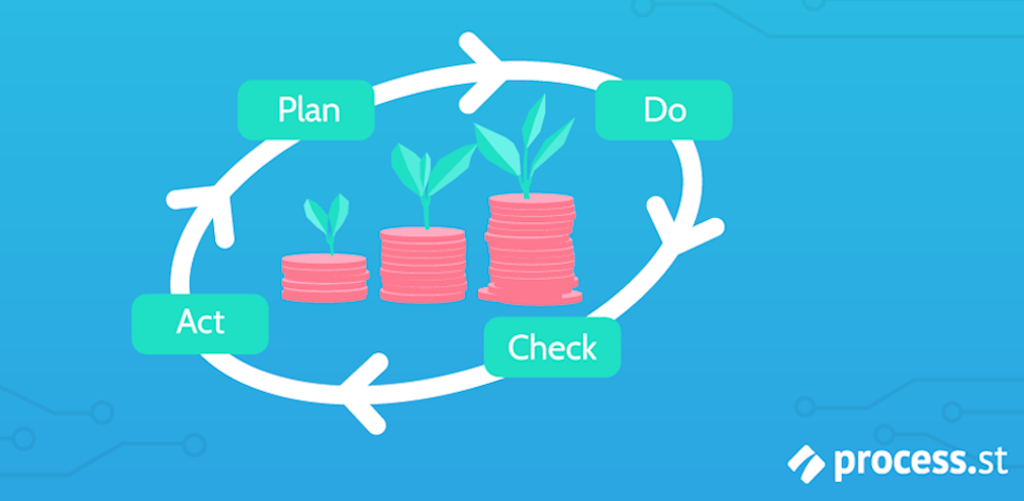
- Plan stage 1 – Document your business processes: First you need to document your business processes. Using a document management system such as Process Street makes process documentation a breeze. For more information on how to document business processes read; The Complete Guide to Business Process Management.
- Plan stage 2 – Assess your business processes: Continually assess each business process, critically analyze operations against sustainability values and needs.
- Plan stage 3 – Identify the gap: Compare your performance with the desired performance.
- Do – Improve your business processes: Make the alterations needed to your business processes to close the gap between sustainability needs and your actual performance. These alterations should be intertwined within your business processes taking the integrated management systems approach.
- Test – Observe the success of the alterations made: Check your processes against intended outcomes. Are the changes producing the desired results? Have new problems arisen with the alterations made?
- Act – Audit and improve your processes: Identify new gaps or previous gaps that have not yet closed. Plan to address sustainability goals not reached. Repeat the process.
For Dan Edmonson from Dronegenity LLC, keeping a documented Integrated Sustainability Strategy is essential for meeting his goals.
“Keeping documentation of our Integrated Sustainability Strategy is essential to verify that we are meeting or hopefully exceeding our intended goals. The most useful method we use is checklists, as this allows us to mark completed tasks and see the progression in total completion.”
To implement an Integrated Sustainability Strategy, you need to document your business operations for full transparency. With this you will know:
- Every task you execute and the environmental impact
- Tasks that can be altered for greater sustainability
- Gaping holes for innovation
To help you get started with an Integrated Sustainability Strategy, use our ISO 9001 and ISO 14001 Integrated Management System (IMS) Checklist.
ISO 9001 and ISO 14001 Integrated Management System (IMS) Checklist
Click here to access the ISO 9001 and ISO 14001 Integrated Management System (IMS) Checklist.
Run this checklist to integrate your ISO 9001 Quality Management System (QMS) with your ISO 14001 Environmental Management System (EMS). The need for implementing both an EMS and QMS together in a single Integrated Management System has existed for a long time, and the trend is only growing. The best solution for this is to take them both on in one fell swoop, in the form of an integrated management system.
This checklist is designed to help you integrate your existing EMS and QMS policies and procedures, and consolidate two separate manuals into one.
By implementing both standards together into a single reference point, you will save yourself time and money by not having to do twice the work to update two separate management systems.
It will also allow you to align the environmental objectives with quality policies, and achieve further synergy between the two systems in service of your overarching business goals.
Use Process Street as a tool to help you achieve corporate sustainability
Process Street is superpowered checklists. You can use Process Street as your virtual Business Process Management tool, which includes the management and implementation of your corporate sustainability approaches.
With Process Street, business operations are recorded in the cloud via a checklist. I have already presented you with 5 top templates that will help you achieve your corporate sustainability goals at the beginning of this article. However, for a more comprehensive list of our free to use templates, scroll down to the end of this article.
In these templates, you will find following features:
- Stop tasks to ensure task order.
- Dynamic due dates, so no deadline is missed.
- Conditional logic, creating dynamic templates that cater to your needs.
- Role assignments, to ease task delegation within your team.
- Approvals, allowing decision-makers to give the go-ahead (or rejection) on important items. Also, necessary comments can be provided.
With Process Street, you can:
- Go paperless: Your business operations are documented and secured in the cloud. This can be anything from onboarding a new client, to creating an invoice. All vital information is recorded in the Process Street checklist. Emails, Google Documents, you name it, can then be automatically created at a click of a button, and sent to the relevant team members. Paper becomes superfluous. For instance, in my position as a content writer, I never use paper.
- Go remote: With documented, on-cloud stored business operations, work processes can be managed from anywhere at any time. The Process Street team all work 100% remotely. Every process for a job can be followed as required, with each vital step detailed in a checklist. Team communication and collaboration can occur within a Process Street checklist, whilst also utilizing applications such as Zoom and Slack.
- Paradigm shifts: Process Street has a wealth of pre-made templates that you can follow to harness the company culture you desire to meet for your sustainability efforts. Checklists such as our Diversity Hiring Process and our Code of Conduct Policy Adherence Process will help you get started. For more, check out our template library.
- Innovate: With Process Street you can improve your business processes at the core, instead of haphazardly applying a simple solution to the complex corporate sustainability problems. Think of this as process innovation. For more information on Process Innovation, read: How to Use Visual Process Innovation to Make Your Startup More Efficient.
- Integrated Sustainability Strategy: Documenting your processes in Process Street means you are in a sure-fine position to implement an Integrated Sustainability Strategy, to achieve your corporate sustainability goals, as already discussed above. You need sustainable processes to make your sustainability efforts work.
For more information on how to create checklists using Process Street – for free – watch our below video.
Be pioneers in corporate sustainability, with a future-driven view for short-term and long-term success
Sustainability in the corporate world is vital if we want to preserve society and our economy as we know it. Change is inevitable, but with a sturdy foundation – one that includes the economic, societal and environmental pillars to business – corporations are better equipped to deal with this inevitable change.
We and our businesses belong in an intertwining system, composed of a multitude of interacting factors. We need to understand these interactions, to solve our complex sustainability problems with meticulous solutions. By speaking with business experts across the globe, we have highlighted 5 top approaches for becoming more sustainable, namely:
- Going paperless
- Going remote
- Creating and supporting a paradigm shift
- Innovating
- Implementing an Integrated Sustainability Strategy
Process Street is here to help you implement your corporate sustainability solutions. You can sign up to Process Street for free, today.
As promised, please find Process Street’s free to use templates, that will help you reach your corporate sustainability goals:
- ISO 14001 Environmental Management Self Audit Checklist
- ISO 26000 Social Responsibility Performance Assessment Checklist
- ISO 9001 and ISO 14001 Integrated Management System (IMS) Checklist
- Achieving Work-Life Balance Checklist
- Customer Feedback
- Brand Identity Design
- Accounts Payable Process
- Accounts Receivable Process
- Annual Financial Report Template
- Balance Sheet Statement Preparation Checklist
- Budget Preparation Checklist
- Cash Management Process
- Environmental Accounting Internal Audit
- Expense Management Process
- Financial Management For New Projects
- Financial Plan Template
- Income (Profit and Loss) Statement Process
- Investor Pitch
- Know Your Customer Checklist
- ISO 45001 Occupational Health and Safety (OHS) Audit Checklist
- Hotel Sustainability Audit
- Code of Conduct Policy Adherence Process
- Diversity Hiring Process
- Gap Analysis Template
- ISO 9001 and ISO 14001 Integrated Management System (IMS) Checklist
- ISO 45001 Occupational Health and Safety (OHS) Audit Checklist
- GRI Standards 101: Foundation 2016 Checklist Template
- GRI Standards 102: General Disclosure 2016 Checklist Template
- GRI Standards 103: Management Approach 2016 Checklist Template
- ISO 14001 EMS Mini-Manual Procedures
- ISO 14001 EMS Structure Template
- Risk Management Process
- BSR Greenwash Prevention Checklist
- Ray Dalio’s Process Improvement Method
- The Process for Optimizing a Process
- SMART Goal Setting Checklist
- Work Anxiety Resolution Checklist
- Sales Forecasting Checklist
How do you practice corporate sustainability on a day-to-day basis? What challenges have you faced? What successes have you had? We would love to hear from you, please comment below.







Jane Courtnell
Hi there, I am a Junior Content Writer at Process Street. I graduated in Biology, specializing in Environmental Science at Imperial College London. During my degree, I developed an enthusiasm for writing to communicate environmental issues. I continued my studies at Imperial College's Business School, and with this, my writing progressed looking at sustainability in a business sense. When I am not writing I enjoy being in the mountains, running and rock climbing. Follow me at @JaneCourtnell.